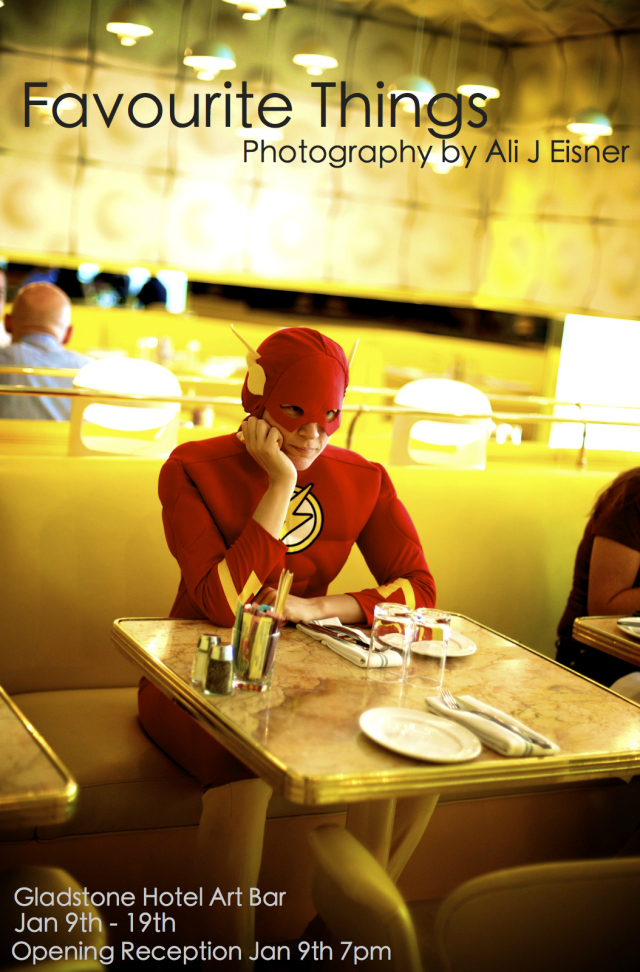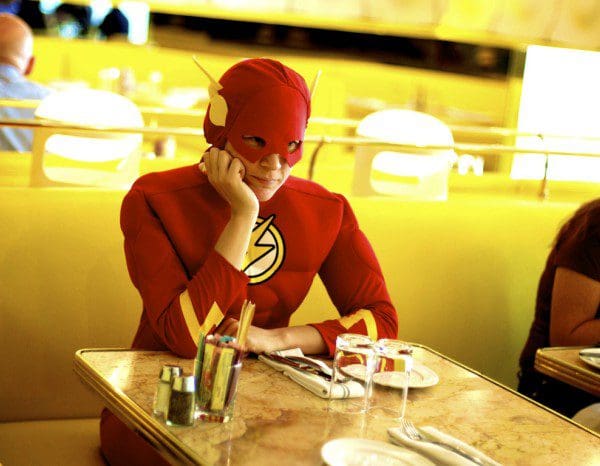 “It’s my first show,” she says to me, beaming. “I’ve been shooting forever! I started on dad’s old school Nikon,” she continues, all in one breath, “I just loved to take pictures!” Ali Eisner is standing beside me, among many others crammed into the Gladstone Hotel’s Art Bar. She wears a dark green, styled hunting hat with red and black houndstooth stitched inside and exposed by her flipped up ear flaps. Her white shirt and black, skinny tie are only visible under an oversized knit sweater. Her bright eyes shine out into the room from under the bill of her cap and it’s patently clear just how excited she is to be showing her photography.
“It’s my first show,” she says to me, beaming. “I’ve been shooting forever! I started on dad’s old school Nikon,” she continues, all in one breath, “I just loved to take pictures!” Ali Eisner is standing beside me, among many others crammed into the Gladstone Hotel’s Art Bar. She wears a dark green, styled hunting hat with red and black houndstooth stitched inside and exposed by her flipped up ear flaps. Her white shirt and black, skinny tie are only visible under an oversized knit sweater. Her bright eyes shine out into the room from under the bill of her cap and it’s patently clear just how excited she is to be showing her photography.
The 37 photographs on display, from the very first look, are like her – colourful, forthcoming and honest. She shoots a broad range of subject matter, but frequently features emphasized colour and contrast to tie the series of images together. Technically sharp, Ms. Eisner’s photography makes remarkable use of depth of field and framing to help moments leap out of the frame. Looking at her pictures of “The Good Lovlies,” a Canadian folk trio who got their start at the Gladstone, you can practically hear them singing. The shots feature yellow and brown tones that fade beside the sharp reds and blacks of the Lovlies’ lips and hair. Her “Night Ride” vividly depicts a summer romance, beside a brightly flickering roller-coaster sign: “Zipper.” “Flash Tan,” and “Standing Ovation,” to name a couple, pull striking blues, reds and yellows out of their composition to draw the eye around their surreal composition, which features foreground framing that’s just out of focus. In short, her photographs shout to the people at the far side of the room, “you’ve gotta see this!”
Ms. Eisner’s photography has unusual, striking composition. My favourite photograph on display, a black and white picture of wooden alphabet blocks called “Gimme an R!” shows towers of letters and numbers, turned at all angles towards the lens. The depth of field is so tight that only one set of blocks is truly in-focus. The picture looks so real that it truly does seem like a window into the image. In fact, the feature of Ms. Eisner’s photography that is so unique is not her ability to capture a moment – because, well, it’s photography – but it’s her ability to pick up her audience and place them behind her eyes for a moment. What becomes clear as one walks around her exhibit is not a pervasive style or interesting technical experimentation; what’s on display is the way that Ms. Eisner experiences the world. She sees – honestly – warmth and colour and bold, human moments of love, pride and loneliness.
Ms. Eisner’s photography feels so honest, in part because she only takes pictures with fixed lenses. She demonstrates: “If I stand here, with a fixed lens, it’s different than if I stand [takes a step to her left] here! Isn’t that awesome?! When I got a zoom lens, I realized I could just do this [zooms an imaginary lens] and I thought, well this is bullshit!” While looking at Ms. Eisner’s photography, we’re not only looking through her viewfinder, we’re standing in her shoes. And whether that means we’re at a concert or climbing through rusted-out cars that “look like someone had had 1700 accidents in it,” it certainly means we’re seeing colour and beauty everywhere we go.
Her favourite picture on display is a black and white shot of Rae Spoon. “Rae’s usually got a guitar, but this is a unique, lovely, lonely moment,” she tells me. In the photograph, Rae is seated towards the left side of the frame with a microphone in-hand. The composition and contrast of the shot leaves Rae’s face, hands and the microphone cord, draped across Rae’s knee looking white-hot while their checked shirt and grey v-neck sweater subtly separate Rae from the blackness of the rest of the frame. The darkness that stretches from the pictured figure to the right side of the frame emphasizes just how alone Rae can feel, despite the stage lighting that illuminates their face. The moment is, indeed, lonely and lovely, but it’s incredibly difficult to discern why. Rae’s eyes are downcast and it seems like Ms. Eisner’s caught them in a sheepish, or thoughtful, quiet second. The singer doesn’t seem happy, but the traces of a smile still linger at the corner of their lips. I am not quite sure I’ve ever seen the expression on Rae’s face on anybody else’s face before. And here is what makes Ali Eisner brilliant! She sees things so singularly that the photographs she takes seem familiar and strange all at once. We know what photographs of musicians are like when we first see them from across the room, but on approach, we’ve encountered the way Ms. Eisner sees them – which is just more complex and, if we’re honest with ourselves, better.
When I asked Ms. Eisner about why birds feature so prominently in her work, she looked around the room and exclaimed, “Oh wow! They do! I didn’t even realize it!” On further reflection, she supposed that because “they’re not contained or controlled by anything. I guess they are inspiring to me,” she smiled broadly. She’s right, she doesn’t seem contained or controlled by anything, nor do her photographs.
It is always a remarkable experience to encounter art where content, concept and artist harmonize so sonorously. Ali Eisner’s photography certainly showcases that experience. She offers auto-biographical advice to young photographers: “if you love it, just shoot…Shoot what you see. Shoot what you love.” It’s definitely worked for her.
Ali Eisner’s Favourite Things is on display at the Gladstone Hotel’s Art Bar until January 19th. The photographs are on sale and admission is free. The gallery is open from 12-5pm daily.

